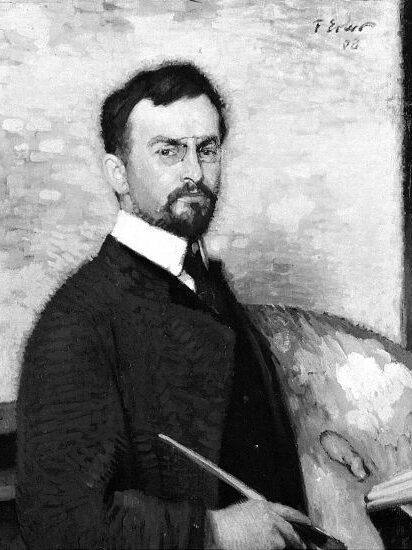Erler, Fritz
Painter, graphic artist
Born: 15.12.1868 in Frankenstein near Breslau
(today Ząbkowice Śląskie)
Died: 11.7.1940 in Munich
Fritz Erler was born in Frankenstein, Silesia, the son of the royal district secretary Friedrich Louis Erler (1834 - 1888) and his wife Ernestine Auguste Berta, née Mayer (1831 - 1915?). The family moved from there to Strehlen in 1875, where Erler attended grammar school. From 1885, he studied at the Royal School of Arts and Crafts in Breslau and became a master student of Albrecht Peter Bräuer (1830 - 1897). In 1889 he went to the art academies in Berlin and Weimar and in 1890 to Munich. In the fall of 1892, he decided to continue his studies in Paris at the private Académie Julian, and in 1894 he finally settled in Munich.
Here, the publisher Georg Hirth (1844 - 1916) and the publicist Fritz von Ostini (1861 - 1927) recruited him to work on the magazine "Jugend", which was to become the mouthpiece of a new, modern style movement, the "Jugendstil". Erler designed the cover of the first issue, which appeared on January 1, 1896, and was a permanent member of the staff until 1916. In 1899, he and a number of other artists founded the Munich artists' group "Scholle", which existed until 1911. In the summer months, they moved to Holzhausen am Ammersee to work. It was here that Erler met Anna Hörger (1880 - 1963), whom he married in 1903. Their son Dietrich was born in 1906. A summer studio house built in Holzhausen in 1904/05 according to his own plans served as the family's permanent residence from 1918.
Already one of the most sought-after artists in Munich at the turn of the century, Erler received the important commission in 1906 to design the southern reading hall, today's Muschelsaal, in the new Wiesbaden Kurhaus (Kurhaus, new). In a very short time and under the most unfavorable conditions, he created five fresco murals. The theme "The Four Seasons" was specified by the architect of the Kurhaus, Friedrich von Thiersch. Work on the murals, which were preserved on site, lasted until shortly before the opening on May 11, 1907 by Emperor Wilhelm II. In the five paintings entitled "Spring", "Summer", "Autumn", "Winter" and "Old Age and Youth", Erler, still very much associated with Art Nouveau, created unconventional and original interpretations of the specified themes. Wilhelm II disliked the content and composition of the pictures, the style of painting and the spectacularly bright use of color and criticized them harshly, which considerably increased Erler's fame. At the turn of the year 1907/08, he was awarded the title of royal professor.
During the First World War, Erler was an official war painter. He traveled to the theaters of war and, both shaken and fascinated by the war, produced numerous paintings and prints of heroic and patriotic content, a memorial sheet for the fallen and war bond posters, works with which he was extraordinarily successful and which were widely distributed. In 1916, he was honored with the "King Ludwig Cross" for his services.
After the end of the war, he returned to his earlier pictorial themes, and although the resulting works were no longer stylistically up to date, he continued to be appreciated and awarded commissions. The seizure of power by the National Socialists and the founding of the Reich Chamber of Culture in September 1933 had no immediate negative consequences for Erler. In 1937, he received one last major commission, the awarding of which was dependent on Hitler's approval. It was a cycle of ten large-format glass mosaics for the cashier's hall of the extension to the Reichshauptbank in Berlin. This cycle was Erler's most monumental and at the same time most heroic work; the themes chosen and the Nordic image of humanity shown corresponded to the official ideas of art. Fritz Erler died in 1940 and was buried in the cemetery in Holzhausen. His entire estate was lost in a fire in 1965.
Fritz Erler was a recognized and popular artist of enormous versatility until the First World War. Initially still committed to Art Nouveau, he furnished entire rooms, provided designs for furniture, vases, embroidery, bookplates, book covers and posters, designed stage sets and costumes, and left behind numerous portraits and large-format, decorative murals, frescoes and mosaics. Awarded several gold and silver medals, he was made an honorary member of the Academy of Fine Arts in Munich in 1922, received the "Bavarian Maximilian Order for Science and Art" in 1928 and finally the Hessian State Medal for Outstanding Painting in 1935.
His extensive and difficult to survey oeuvre was almost forgotten, partly due to Erler's indifferent attitude towards the cultural policies of the National Socialists. Many of his works could easily be instrumentalized in line with National Socialist ideology. His closeness to the regime is also documented by numerous portraits of Nazi celebrities, which he produced on official commission, including two large-format portraits of Hitler.
The Museum Wiesbaden owns numerous works by Erler, including designs for the Kurhaus frescoes, a self-portrait (1913) and a portrait of his wife by the sea (1906) and several paintings that heroize the German soldier in the First World War.
Literature
- Schroeter, Christina
Fritz Erler: Life and Work, Hamburg 1992.
- Unterberger, Siegfried u.a. (Hrsg.)
Die Scholle. Eine Künstlergruppe zwischen Secession und Blauer Reiter, Munich et al. 2007.
- Schroeter-Herrel, Christina
Erler, Fritz (1868). In: AKL Online (Allgemeines Künstlerlexikon), Berlin/New York, Dok-ID: _10206733 (retrieved 11/2011).
- Klar, Alexander (Hrsg.)
Fritz Erler. From the plaice to the war, Cologne 2016.
